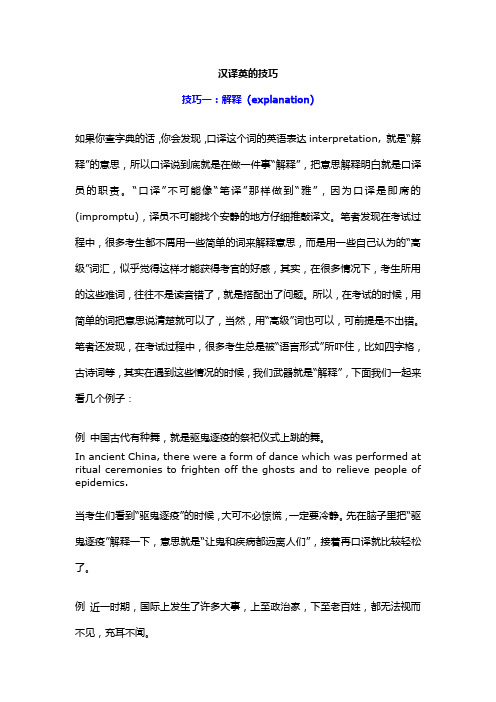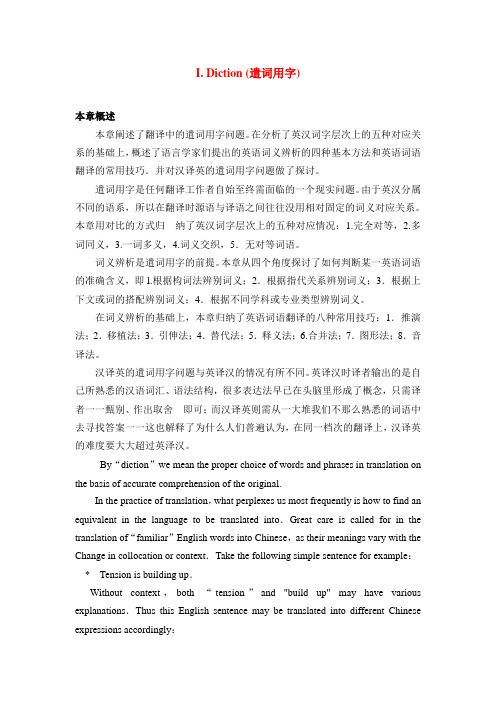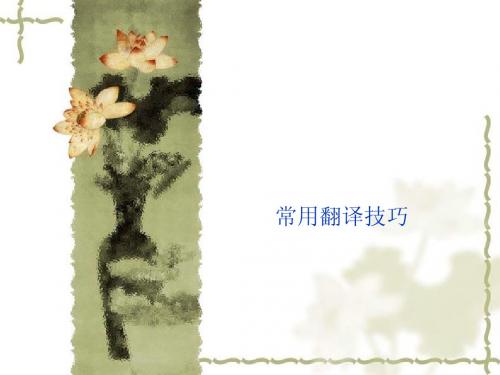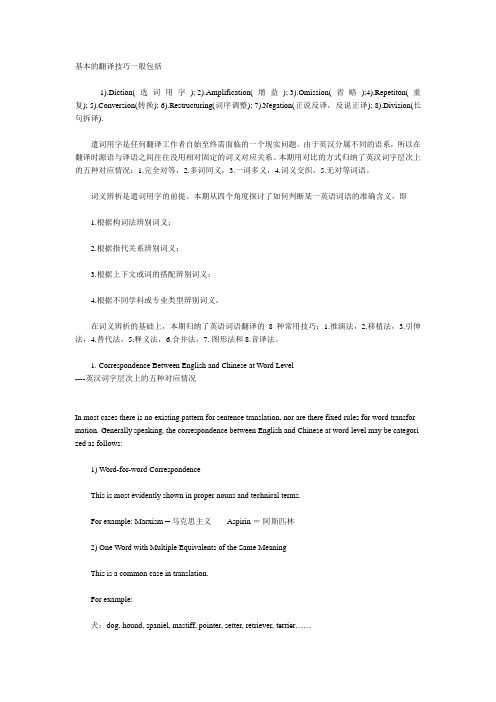翻译技巧1 diction
翻译中的遣词用句

基本的翻译技巧一般包括1).Diction(选词用字); 2).Amplification(增益); 3).Omission(省略);4).Repetiton(重复);5).Conversion(转换); 6).Restructuring(词序调整); 7).Negation(正说反译,反说正译);8).Division(长句拆译).遣词用字是任何翻译工作者自始至终需面临的一个现实问题。
由于英汉分属不同的语系,所以在翻译时源语与译语之间往往没用相对固定的词义对应关系。
本期用对比的方式归纳了英汉词字层次上的五种对应情况:1.完全对等,2.多词同义,3.一词多义,4.词义交织,5.无对等词语。
词义辨析是遣词用字的前提。
本期从四个角度探讨了如何判断某一英语词语的准确含义,即1.根据构词法辨别词义;2.根据指代关系辨别词义;3.根据上下文或词的搭配辨别词义;4.根据不同学科或专业类型辨别词义。
在词义辨析的基础上,本期归纳了英语词语翻译的8种常用技巧:1.推演法,2.移植法,3.引伸法,4.替代法,5.释义法,6.合并法,7. 图形法和8.音译法。
1. Correspondence Between English and Chinese at Word Level----英汉词字层次上的五种对应情况In most cases there is no existing pattern for sentence translation, nor are there fixed rules for word transformation. Generally speaking, the correspondence between English and Chinese at word level may be categorized as follows:1) Word-for-word CorrespondenceThis is most evidently shown in proper nouns and technical terms.For example: Marxism = 马克思主义Aspirin =阿斯匹林2) One Word with Multiple Equivalents of the Same MeaningThis is a common case in translation.For example:犬:dog, hound, spaniel, mastiff, pointer, setter, retriever, terrier……3) One Word with Several Equivalents of Different MeaningThis is also very common in translation. For example:carry: 搬、运、送、提、拎、挑、担、抬、背、扛、搂、抱、端、举、夹、捧…..走:walk, saunter, amble, stride, trudge, trapes, shamble, prance, scamper, clump, tiptoe ….羊:sheep, goat, ram, ewe, lamb……4) Equivalents Interwoven with One Another5) Words Without EquivalentsIn this case, an explanation is given instead of an equivalent.For example:clock-watcher: 老是看钟等下班的人阴:(in Chinese thought) the soft inactive female principle or force in the world阳:(in Chinese thought) the strong active male principle or force in the world(目不识)丁: (not know one's) ABC2. Methods to Discriminate the Original Meaning of an English Word-----词义辨析Since English words are prone to various meanings, it is of vital importance for a translator to discern the right meaning of a given word. And the following are the major methods of discriminating word meaning suggested by some linguists.1) Judging from the Word FormationIn order to discriminate the original meaning of an English word, it is necessary for us to have a knowledge of English lexicology, and specifically, a knowledge of word formation, such as compounding, derivation, affixation, blending, acronym, clipping, etc. A good command of them will help to shed light on the correct meaning of some difficult words.For example, the word ""parabiospheric"", which consists of para-(outside) +bio-(biologic) +spheric (having the form of a sphere). After a brief analysis, we may safely put it into ""外生物层的"". Another more complicated instance, pneumonoultramicroscopicsilicovolcanoconiosis. This extremely long word seems appallingly complicated. However, an anatomic study of its composition enables us to get a clear understanding of its meaning: pneumono- (of lung) +ultra- (beyond) + micro (very small) + scopic- (of viewing or observing) + silico- (of silicon)+ volcano + coni- ( koni, of dust) + osis (forming the name of a disease). Even if we are not sure of the equivalent of this medical term, we may roughly get the right meaning of the long word: a kind of lung disease caused by extremely small silicon particles. And a look into some dictionary leads us to the definite answer: 硅酸盐沉着病,肺尘病(一种矿工易染的病)。
英汉互译简明教程Translation Techniques

They live frugally to accumulate more funds for the state .
Note:不要进行字对字的死译。要考虑中英文的真正含义。
2021/7/17
10
II. Choice of Word Meanings According to Different Collocation.
英汉互译简明教程Translation Techniques
Translation Techniques
Generally speaking, the basic translation techniques that merit our attention and are to be applied in English-Chinese or ChineseEnglish translations include:
• The same word with the same part of speech may have different meanings due to different collocations.
For example: Delicate
Delicate skin Delicate porcelain Delicate upbringing Delicate living Delicate health Delicate stomach Delicate vase Delicate diplomatic question Delicate difference Delicate surgical operation
1.Diction(遣词用字) (重译法) (增译法) (减译法) (转换法) (词序调整法) (正说反译,反说正译法) 8.Change of Voices(语态变换法) (分译法) (合译法)
choice of _diction翻译中的选词

选词的简洁
准确是简洁的前提, 简洁也是准确的保障。英国散文创作 方面的权威都认同“言贵简洁”, 并奉之为圭臬。在 Williams trunk, Jr. 和E. B. White 的The elements of style 一 书中提到: Vigorous writings concise. A sentence should contain no unnecessary words, a paragraph no unnecessary sentences, for the same reason that drawings have no unnecessary lines and a machine no unnecessary parts. 也就 是说任何单词只要不能给句子的内容增添任何新的意义, 就应该被删掉。
cousin堂兄、堂弟、堂姐、堂妹、表哥、表弟、表姐、 堂兄、堂弟、堂姐、堂妹、表哥、表弟、表姐、 堂兄 表妹、 表妹、卿…… president总统、总裁、主席、董事长、议长、会长、 总统、总裁、主席、董事长、议长、会长、 总统 社长、校长…… 社长、校长 carry搬、运、送、提洪、挑,担、抬、背,扛、搂、 搬 提洪、 抱、端、举、夹、捧…… walk, saunter, amble, stride, trudge, shamble, prance, tiptoe ...走 走 machine, engine, plane, aircraft...机 机 sheep, goat, ram, ewe, lamb...羊 羊
Those who do not remember the past are condemned to relive it. 凡是忘掉过去的人注定要重蹈覆辙。 Relive 需要用贬义来表达。
常用翻译技巧

1)Diction(选词用字)2)Amplification(增词法)3)Omission(省略法)4)Conversion(转换法)5)Repetition(重复法)6)Inversion(语序调整)7)Negation(正说反译,反说正译)8)Division (长句拆译) & Subordination(分清主从)例1. Neat people buy everything in expensive little single portions.意译:办事讲究的人买什么都讲少而精,愿买贵的。
√例2.They want quality, but at a budget price.意译:他们又要货好,又要价格合算。
√people at budget:精打细算过日子的人例3.On Taiwan there was little grace and less give between the two sides.在台湾问题上,双方几乎没有多少客气可讲,更谈不上让步了。
例4. Whichever way you choose to visit Zhengzhou , you will reach here quickly and enjoy a comfortable stay, because Zhengzhou has a wide range of accommodation to suit all budgets and tastes…试译:无论乘坐何种交通工具都能迅速抵达郑州,下榻此处会让你倍感舒适,这里的住宿条件能充分满足各种档次和品味的要求……。
例4.New HSR and Maglev would have all-new, state-of-the-art train control system. The Accelerail options were estimate with train control systems providing speed and authority enforcement.译文:新型高速列车或磁浮列车须装置全新的、造形精美的列车操纵系统,可供选用的列车操纵系统必须能提供速度和(威力)强大的加速力。
汉译英技巧

汉译英的技巧技巧一:解释(explanation)如果你查字典的话,你会发现,口译这个词的英语表达interpretation, 就是“解释”的意思,所以口译说到底就是在做一件事“解释”,把意思解释明白就是口译员的职责。
“口译”不可能像“笔译”那样做到“雅”,因为口译是即席的(impromptu),译员不可能找个安静的地方仔细推敲译文。
笔者发现在考试过程中,很多考生都不屑用一些简单的词来解释意思,而是用一些自己认为的“高级”词汇,似乎觉得这样才能获得考官的好感,其实,在很多情况下,考生所用的这些难词,往往不是读音错了,就是搭配出了问题。
所以,在考试的时候,用简单的词把意思说清楚就可以了,当然,用“高级”词也可以,可前提是不出错。
笔者还发现,在考试过程中,很多考生总是被“语言形式”所吓住,比如四字格,古诗词等,其实在遇到这些情况的时候,我们武器就是“解释”,下面我们一起来看几个例子:例中国古代有种舞,就是驱鬼逐疫的祭祀仪式上跳的舞。
In ancient China, there were a form of dance which was performed at ritual ceremonies to frighten off the ghosts and to relieve people of epidemics.当考生们看到“驱鬼逐疫”的时候,大可不必惊慌,一定要冷静。
先在脑子里把“驱鬼逐疫”解释一下,意思就是“让鬼和疾病都远离人们”,接着再口译就比较轻松了。
例近一时期,国际上发生了许多大事,上至政治家,下至老百姓,都无法视而不见,充耳不闻。
Some major events have taken place in recent months. None of us, from politicians to people in the street, can afford to overlook.“都无法视而不见,充耳不闻。
Diction (遣词用字)

I. Diction (遣词用字)本章概述本章阐述了翻译中的遣词用字问题。
在分析了英汉词字层次上的五种对应关系的基础上,概述了语言学家们提出的英语词义辨析的四种基本方法和英语词语翻译的常用技巧.并对汉译英的遣词用字问题做了探讨。
遣词用字是任何翻译工作者自始至终需面临的一个现实问题。
由于英汉分属不同的语系,所以在翻译时源语与译语之间往往没用相对固定的词义对应关系。
本章用对比的方式归纳了英汉词字层次上的五种对应情况:1.完全对等,2.多词同义,3.一词多义,4.词义交织,5.无对等词语。
词义辨析是遣词用字的前提。
本章从四个角度探讨了如何判断某一英语词语的准确含义,即l.根据构词法辨别词义;2.根据指代关系辨别词义;3.根据上下文或词的搭配辨别词义;4.根据不同学科或专业类型辨别词义。
在词义辨析的基础上,本章归纳了英语词语翻译的八种常用技巧:1.推演法;2.移植法;3.引伸法;4.替代法;5.释义法;6.合并法;7.图形法;8.音译法。
汉译英的遣词用字问题与英译汉的情况有所不同。
英译汉时译者输出的是自己所熟悉的汉语词汇、语法结构,很多表达法早已在头脑里形成了概念,只需译者一一甄别、作出取舍即可;而汉译英则需从一大堆我们不那么熟悉的词语中去寻找答案一一这也解释了为什么人们普遍认为,在同一档次的翻译上,汉译英的难度要大大超过英泽汉。
By“diction”we mean the proper choice of words and phrases in translation on the basis of accurate comprehension of the original.In the practice of translation,what perplexes us most frequently is how to find an equivalent in the language to be translated into.Great care is called for in the translation of“familiar”English words into Chinese,as their meanings vary with the Change in collocation or context.Take the following simple sentence for example:* Tension is building up.Without context,both “tension”and "build up" may have various explanations.Thus this English sentence may be translated into different Chinese expressions accordingly:·形势紧张起来。
第2章 常用翻译技巧

译文: 我们认识到,自由贸易并非一种损人利 己的“零和值”游戏。 (语义性增译)
例5.(?)信笔写来,(?)竟然差不多都是写我 自己的回忆,这(?)就说明了这本散文集的魅 力。 While writing at will, I find all I’ve done is just something of my own recollection, which shows how charming this collection of essays is! (结构增译)
例7.有市场、有效益的速度,才是真正的发 展,才是硬道理。 Sound economic growth must be based on strong market demand and good economic returns. This is a fundamental principle.
中国人的生活中充满了一系 列“名牌”、“上品”之 类的东西:筵席上的茅台属 中国八大名酒之一,杭州西 湖属中国九大名胜之一,就 连一些公司也要自称是全国 500强企业之一。 (语义性增译)
例3.Venice invites idleness and strolling. Its silence is restful and its sundials are inscribed with the words: Horas non mumero nisi serenas (I count only the happy hours). “邀请悠闲和散步, 安宁是静止的”?
例8.“一要吃饭,二要建设”是指导我国经 济工作的基本原则。 A basic principle guiding our economic work is “subsistence first and development second”.
基本的翻译技巧一般包括

基本的翻译技巧一般包括1).Diction(选词用字); 2).Amplification(增益); 3).Omission(省略);4).Repetiton(重复); 5).Conversion(转换); 6).Restructuring(词序调整); 7).Negation(正说反译,反说正译); 8).Division(长句拆译).遣词用字是任何翻译工作者自始至终需面临的一个现实问题。
由于英汉分属不同的语系,所以在翻译时源语与译语之间往往没用相对固定的词义对应关系。
本期用对比的方式归纳了英汉词字层次上的五种对应情况:1.完全对等,2.多词同义,3.一词多义,4.词义交织,5.无对等词语。
词义辨析是遣词用字的前提。
本期从四个角度探讨了如何判断某一英语词语的准确含义,即1.根据构词法辨别词义;2.根据指代关系辨别词义;3.根据上下文或词的搭配辨别词义;4.根据不同学科或专业类型辨别词义。
在词义辨析的基础上,本期归纳了英语词语翻译的8种常用技巧:1.推演法,2.移植法,3.引伸法,4.替代法,5.释义法,6.合并法,7. 图形法和8.音译法。
1. Correspondence Between English and Chinese at Word Level----英汉词字层次上的五种对应情况In most cases there is no existing pattern for sentence translation, nor are there fixed rules for word transfor mation. Generally speaking, the correspondence between English and Chinese at word level may be categori zed as follows:1) Word-for-word CorrespondenceThis is most evidently shown in proper nouns and technical terms.For example: Marxism = 马克思主义Aspirin =阿斯匹林2) One Word with Multiple Equivalents of the Same MeaningThis is a common case in translation.For example:犬:dog, hound, spaniel, mastiff, pointer, setter, retriever, terrier……3) One Word with Several Equivalents of Different MeaningThis is also very common in translation. For example:carry: 搬、运、送、提、拎、挑、担、抬、背、扛、搂、抱、端、举、夹、捧…..走:walk, saunter, amble, stride, trudge, trapes, shamble, prance, scamper, clump, tiptoe ….羊: sheep, goat, ram, ewe, lamb……4) Equivalents Interwoven with One Another5) Words Without EquivalentsIn this case, an explanation is given instead of an equivalent.For example:clock-watcher: 老是看钟等下班的人阴: (in Chinese thought) the soft inactive female principle or force in the world阳: (in Chinese thought) the strong active male principle or force in the world(目不识)丁: (not know one's) ABC2. Methods to Discriminate the Original Meaning of an English Word-----词义辨析Since English words are prone to various meanings, it is of vital importance for a translator to discern the rig ht meaning of a given word. And the following are the major methods of discriminating word meaning sugge sted by some linguists.1) Judging from the Word FormationIn order to discriminate the original meaning of an English word, it is necessary for us to have a knowledge of English lexicology, and specifically, a knowledge of word formation, such as compounding, derivation, af fixation, blending, acronym, clipping, etc. A good command of them will help to shed light on the correct me aning of some difficult words.For example, the word ""parabiospheric"", which consists of para-(outside) +bio-(biologic) +spheric (havingthe form of a sphere). After a brief analysis, we may safely put it into ""外生物层的"". Another more complicated instance, pneumonoultramicroscopicsilicovolcanoconiosis. This extremely lon g word seems appallingly complicated. However, an anatomic study of its composition enables us to get a cl ear understanding of its meaning: pneumono- (of lung) +ultra- (beyond) + micro (very small) + scopic- (of vi ewing or observing) + silico- (of silicon)+ volcano + coni- ( koni, of dust) + osis (forming the name of a dise ase). Even if we are not sure of the equivalent of this medical term, we may roughly get the right meaning of the long word: a kind of lung disease caused by extremely small silicon particles. And a look into some dicti onary leads us to the definite answer: 硅酸盐沉着病,肺尘病(一种矿工易染的病)。
- 1、下载文档前请自行甄别文档内容的完整性,平台不提供额外的编辑、内容补充、找答案等附加服务。
- 2、"仅部分预览"的文档,不可在线预览部分如存在完整性等问题,可反馈申请退款(可完整预览的文档不适用该条件!)。
- 3、如文档侵犯您的权益,请联系客服反馈,我们会尽快为您处理(人工客服工作时间:9:00-18:30)。
Translation Techniques
Speaking of translation techniques, we differ from those who tend to ignore them, or dismiss them lightly as something inconsequential. On the other hand, we also differ from those who tend to exaggerate the importance of translation techniques, or to look upon them as “panacea”(万灵药). Generally speaking, the basic translation techniques that merit our attention and are to be applied in English-Chinese or ChineseEnglish translations include:
Tension is building up. Without context, both “tension” and “build up” may have various explanations. Thus this sentence may be translated into different Chinese expressions accordingly: 形势紧张起来。/电压在加强。/张力在 增大。/ 压力在增强。
4) Equivalents Interwoven with One Another
Say Speak
Talk Tell
说 讲
谈 诉
这可说不得。 我代他向你说 话。 他说他很忙。 他说英语。 别胡说。 我说不好。
It must not be mentioned. I appeal to you on his behalf. He says he is busy. He speaks English. Don‟t talk nonsense. I am unable to express myself.
1) Word-for-word Correspondence
This is most evidently shown in proper nouns and technical terms. Eg. Marxism 马克思主义 Aspirin 阿斯匹灵 Laser 激光 Leukemia 白血病
1 Correspondence Between English and Chinese at Word Level
In most cases, there is no existing pattern for sentence translation, nor are there fixed rules for word transformation. Generally speaking, the correspondence between English and Chinese at word level may be categorized as follows:
Warming-up exercises:
1. The School of the Air (the school of the air) 2. Last evening I went to a do held by our China Study Group. 3. The see of Sydney 4. He’s unhappy now, because he had a blue with his friend just now. 5. She told me that her 18-year-old son was the baby. 6. Her mother is a sister in a Melbourne hospital. 7. 王教授精通小学和《大学》 8. 毛泽东同志的思想和学说是永存的; 关于社会注意建设总路线的基本思想; 破除迷信,解放思想; 毛泽东军事思想的一个重要组成部分,是关于人民 战争的思想; 政治问题和思想问题。
词的正确选择首先取决于对原文词义的 确切理解,而对原文词义的确切理解又 取决于对原文上下文的推敲。用词要忠 于原文,不能凭“大概”“差不多”。 这就要弄懂汉语的意思和所用英文词汇 的真正准确含义。如:
1他们省吃俭用,为的是替国家多积累资金。 They save food and expenses to accumulate more funds for the country. (save food: “把食物放起 来”) 改译:They live frugally to accumulate more funds for the state . Note:不要进行字对字的死译。要考虑中英文 的真正含义。
6. 她母亲是墨尔本一家医院的护士长。 (sister: n. senior nurse in a hospital护士长或 者市资历高的护士) 7. Professor Wang is a master of the study of ancient forms, phonology and meaning of written languages as well as the book The Great Learning. 小学不能译为primary school and elementally school,《大学》不能译为university之类。因 为 “小学”的意思“指研究文字古字形、训 诂、音韵的学问;《大学》时我国的古代经 典著作《四书》之一。”
1) Word-for-word Correspondence 2) One Word with Multiple Equivalents of the Same Meaning 3) One Word with Several Equivalents of the Different Meanings 4) Equivalents Interwoven with One Another 5) Words without Equivalents
2 Distinguish the meaning
总体说来,在英汉翻译中要真正准确地 理解英语词语的意义,往往要从以下四 个方面入手:(1)根据上下文进行判 断;(2)根据搭配来进行判断;(3) 根据语法形式来进行判断;(4)根据 词在句中的词类来进行判断。
1) Distinguish the original meaning of an English word by means of context
1. 广播学校(通过电台对各地的学生授课的学校) 误:空军学校 2. 昨晚我去参加了我们中国研究组的集会。 (do: n. social function 集会,娱乐宴聚活动)误: 把do译成了“从事活动” 3. 悉尼教廷 (see: n. the official seat, or centre of authority, of a bishop教廷) 4. 他正闷闷不乐,因他刚才和朋友吵了架。 (blue: n. an argument, quarrel or fight争吵或干 架) 5. 他对我说她那18岁的儿子是她子女中最小的。 (baby: n. a person of any age, who is the youngest of a family among brothers and sisters兄 弟姐妹中最小的)
5) Words without Equivalents
这种情况必须改变。 现在的情况不同了。 他们的情况怎么样? 前线有什么情况? 我 state of affairs must change. Now things are different. How do matters stand with them? How is the situation at the front? We may go there, but that depends.
1. Diction
By “diction” we mean the proper choice of words and phrases in translation on the basis of accurate comprehension of the original. In the practice of translation, what perplexes us most frequently is how to find an equivalent in the language to be translated into. Great care is called for in the translation of “familiar” English into Chinese, as their meaning vary with the change in collocation or context.
8. Comrade Mao Zedong‟s thought and teachings will live for ever. The ideas underlying the general line for building socialism. Do away with all fetishes and superstitions and emancipate the mind. An important component of chairman Mao‟s military thinking is his concept of people‟ war. Political and ideology question
